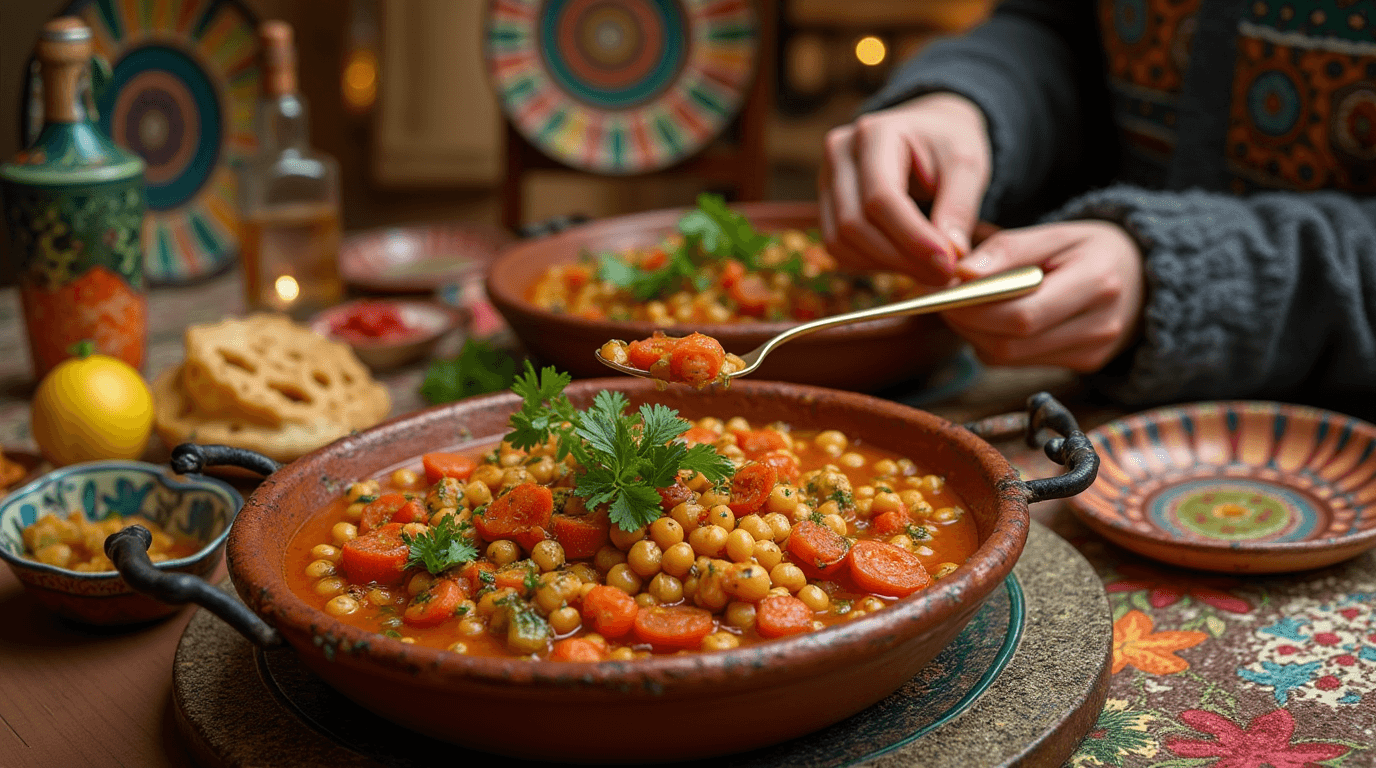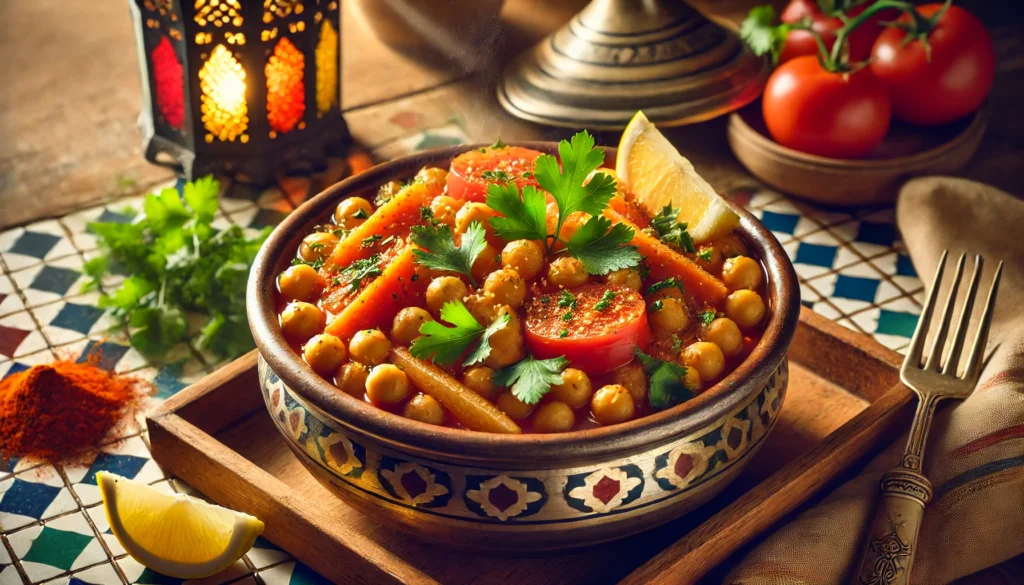Our Location
304 North Cardinal St.
Dorchester Center, MA 02124

Did you know that a single serving of Moroccan chickpea stew contains more fiber than 6 slices of whole wheat bread while delivering essential nutrients from 12+ different plant sources? While many home cooks shy away from international cuisine, thinking it requires exotic ingredients or complicated techniques, Moroccan chickpea stew proves this assumption wrong.
This hearty North African classic combines pantry staples with warming spices to create a deeply satisfying meal that’s both budget-friendly and nutritionally dense. Chickpea stew is one of the most versatile dishes gaining popularity in global kitchens, as chickpea stew offers a perfect blend of flavors and nutritional value that suits contemporary lifestyles.
Whether you’re looking for a meat-free Monday option or a comforting dish to warm up winter evenings, these seven variations of Moroccan chickpea stew offer something for everyone, from traditional recipes to modern interpretations that maintain authentic flavors while accommodating diverse dietary preferences.
For the Base:
Spice Blend:
For Finishing:
Heat olive oil in a large, heavy-bottomed pot or Dutch oven over medium heat. Add the onion and sauté for 4-5 minutes until translucent. Add the garlic and cook for another 30 seconds until fragrant. This aromatic base creates the foundation of flavors that will permeate your Moroccan chickpea stew.
Add all the spices (cumin, coriander, paprika, cinnamon, ginger, cayenne, salt, and pepper) and stir continuously for 1 minute. This crucial step “blooms” the spices, releasing their essential oils and enhancing their flavors – a technique used in Moroccan kitchens for centuries to develop complex flavor profiles.
Add the carrots, celery, and bell pepper, stirring to coat with the spices. Cook for 5 minutes until the vegetables begin to soften. Add the chickpeas, diced tomatoes with their juice, sweet potato cubes, and dried apricots. Pour in the vegetable broth and add the bay leaf.
Bring the stew to a boil, then reduce heat to low. Cover and simmer for 30-35 minutes, stirring occasionally, until the sweet potatoes are tender and the stew has thickened slightly. For a thicker consistency, you can mash some of the chickpeas against the side of the pot with the back of your spoon.
Remove from heat and stir in the lemon juice. Discard the bay leaf. Taste and adjust seasonings as needed. Serve hot, garnished with fresh cilantro, mint (if using), and toasted almonds for a textural contrast that elevates the finished dish.
Chickpea stew can be adapted to suit various dietary requirements. For example, traditional chickpea stew can be transformed into a low-carbohydrate version by reducing the amount of sweet potato and replacing it with more leafy greens. Those following keto diets can enjoy chickpea stew in smaller portions while emphasizing the olive oil and adding healthy fats like avocado as a garnish.
Serve this aromatic Moroccan chickpea stew over fluffy whole grain couscous or quinoa to soak up the flavorful broth. For a more traditional presentation, pair it with warm, homemade flatbread or pita for scooping. A dollop of cooling yogurt (regular or plant-based) balances the warming spices, while a sprinkle of preserved lemon adds authentic brightness. For a complete meal, serve alongside a simple arugula salad dressed with lemon and olive oil.
This Moroccan chickpea stew actually improves with time as flavors meld together. Store in an airtight container in the refrigerator for up to 4 days. When reheating, add a splash of broth or water to maintain the stew’s consistency, as the chickpeas will continue to absorb liquid during storage.
For meal prep, you can freeze portions in freezer-safe containers for up to 3 months. Thaw overnight in the refrigerator before reheating gently on the stovetop. To preserve the fresh taste, add a squeeze of lemon juice and fresh herbs just before serving reheated portions.
Pressure cooking reduces total preparation time to just 30 minutes while intensifying flavors. This version adds a touch of harissa paste for deeper heat and complexity.
This set-it-and-forget-it variation combines chickpeas and red lentils for a protein-packed meal that develops rich flavors over 6-8 hours of gentle cooking.
Packed with seasonal vegetables like zucchini, eggplant, and bell peppers, this colorful version offers maximum nutritional variety and visual appeal.
For heat lovers, this recipe amps up the traditional spice blend with additional cayenne, fresh chili peppers, and a touch of harissa for a warming kick.
Featuring extra sweet potatoes and a cinnamon-forward spice profile, this slightly sweeter variation pairs beautifully with tangy preserved lemons.
This nutrition powerhouse incorporates leafy greens for additional vitamins, minerals, and antioxidants while maintaining traditional Moroccan flavors.
Moroccan chickpea stew offers an ideal balance of nutrition, flavor, and comfort in a single pot. These seven recipes demonstrate the versatility of this North African classic, from traditional preparations to adaptations that fit modern dietary needs while honoring authentic flavor profiles. With simple ingredients, straightforward techniques, and impressive nutritional benefits, this dish deserves a regular spot in your meal rotation.
Thanks to its versatility and ease of preparation, chickpea stew has become a favorite option for family meals and gatherings. Whether you’re searching for a traditional chickpea stew recipe or a modified version that suits your specific dietary needs, these seven recipes provide an excellent starting point for exploring the flavors of Moroccan cuisine. The beauty of chickpea stew lies in its adaptability – you can adjust spices, add seasonal vegetables, or modify cooking methods while still maintaining the core identity of this beloved dish.
Ready to bring the aromatic flavors of Morocco to your kitchen? Try one of these chickpea stew recipes this week and share your experience in the comments below! Don’t forget to subscribe to our blog for more globally-inspired, nutritious recipes delivered straight to your inbox.

Q: Can I make Moroccan chickpea stew without dried fruit? A: Absolutely! While dried apricots or raisins add traditional sweetness that balances the savory elements, you can omit them or substitute with 1 tablespoon of honey or maple syrup for a different kind of sweetness, or simply leave it out for a fully savory version.
Q: What is the best way to serve Moroccan chickpea stew? A: Traditionally, it’s served over couscous, but it’s equally delicious with quinoa, brown rice, or crusty bread. For a lower-carb option, try cauliflower rice or enjoy it as a thick soup on its own.
Q: How can I make this stew spicier? A: For additional heat, increase the cayenne pepper to 1/2 teaspoon, add 1-2 tablespoons of harissa paste, or include a finely diced jalapeño or serrano pepper with the other vegetables.
Q: Is Moroccan chickpea stew freezer-friendly? A: Yes! This stew freezes beautifully for up to 3 months. Cool completely before transferring to freezer-safe containers. Leave some headspace as the stew will expand when frozen. Thaw overnight in the refrigerator and reheat gently, adding fresh herbs after warming.
Q: Can I use dried chickpeas instead of canned? A: Yes, though you’ll need to plan ahead. Soak 1 cup of dried chickpeas overnight, then cook them separately until tender (about 45-60 minutes) before adding to the stew. This extra step adds depth of flavor, and research indicates home-cooked chickpeas have up to 30% more flavor compounds than canned varieties.
There are no reviews yet. Be the first one to write one.